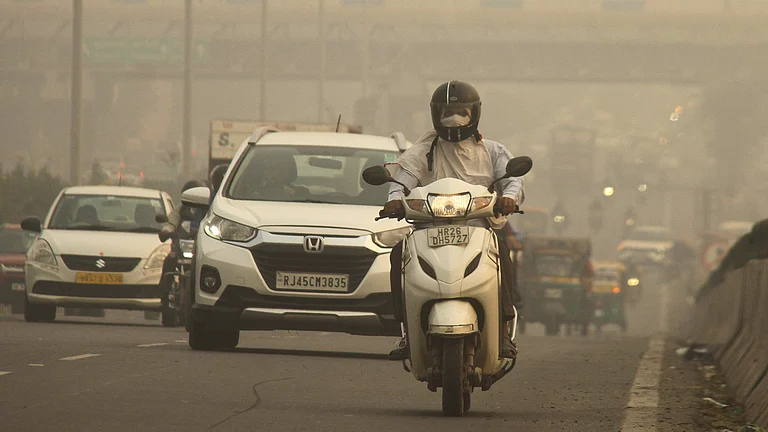Delhi’s AQI remains ‘severe’ for second day, touching 418 on November 12.
Stubble-burning contributes 22% to PM2.5, the season’s highest share yet.
Study links smog to deeper agrarian issues and weak residue management policies.
Toxic Smog Worsens in Delhi Amid Surge in Crop Burning — Here's Why
Farm fires, stagnant winds choke Delhi again as air turns hazardous
The national capital continued to breathe toxic air on November 12 with pollution levels remaining 'severe' for the second straight day at 418, as stubble-burning in the neighbouring regions contributed most to Delhi's foul air.
Delhi's Air Quality Index (AQI) remained 'severe' with the 24-hour average recorded at 418 at 4 pm, according to Central Pollution Control Board (CPCB) data.
A 'severe' AQI poses serious health risks even to healthy individuals, and can affect those with existing respiratory or cardiac conditions badly.
According to the Decision Support System (DSS) data, stubble-burning contributed 22.4% to Delhi's PM2.5 concentration on November 12– the highest share from farm fires recorded so far this winter.
The share of pollution transported from outside the city stood at 15.5 per cent, the DSS data showed.
Delhi recorded its first 'severe' air quality day of the season on November 11, with the overall AQI reaching 428. The air quality, which had been 'very poor' for several days, deteriorated further due to stagnant weather conditions and local emissions.
The CPCB classifies an AQI between 0 and 50 as 'good', 51-100 'satisfactory', 101-200 'moderate', 201-300 'poor', 301-400 'very poor', and 401-500 'severe'.
For Thursday, stubble-burning is projected to contribute around 10.1 per cent to Delhi's PM2.5 levels, while transport-related emissions are expected to increase slightly to 19.3%, according to DSS projections.
Satellite-based data showed 312 farm fire incidents in Punjab, 72 in Haryana, and 322 in Uttar Pradesh on November 11.
According to the Air Quality Early Warning System (AQEWS) for Delhi, the air quality is likely to remain in the 'very poor' category from Thursday onwards.
On the weather front, temperatures continued to dip, with the minimum on Wednesday recorded at 10.4 degrees Celsius, 3.1 notches below normal, and the maximum at 27.7 degrees Celsius, 0.8 notch below normal.
For November 13, the weather department has forecast shallow fog in the morning, with the maximum and minimum temperatures likely to settle around 26 and 11 degrees Celsius, respectively.
Roots of Smog
Citing the Indian Ministry of New and Renewable Energy (MNRE) data, the 2019 study titled Crop Residue Burning in India: Policy Challenges and Potential Solutions in the journal Current Science, stated that India generates on an average 500Mn tonnes (Mt) of crop residue per year. The same report shows that a majority of this crop residue is in fact used as fodder, fuel for other domestic and industrial purposes. However, there is still a surplus of 140 Mt out of which 92 Mt is burned each year. The study noted that the portion burnt as agricultural waste in India, in volume is much larger than the entire production of agricultural waste in other countries in the region.
It further underscored that Delhi’s toxic winter air reflects not just urban emissions but deep-rooted agrarian challenges.
(With inputs from PTI.)

